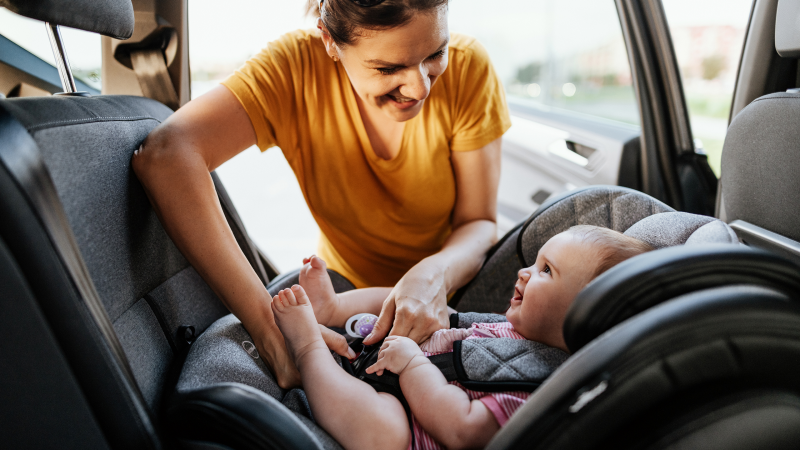Car seat safety 101: What to know to help keep kids safe

For parents, there’s nothing in the world more valuable than their children. Keeping your kids safe is a constant effort, especially when they’re younger. Part of that effort is practicing good car seat safety and ensuring your little ones are in a seat that’s right for them when they’re coming along for the ride.
Why do kids need car seats?
Standard seat belts are designed for someone with adult proportions and may not work as effectively on children. This is where using the right car seat could help keep your child safer. In fact, car seats can help reduce the risk of injury in a crash by up to 71% for children compared to just seat belts, based on data from the National Highway Traffic Safety Administration (NHTSA). For these reasons, car seats are mandatory across the United States of America (although specific requirements and regulations may vary from one region to another).
The world of car seats, however, can be potentially confusing. For first-time seat buyers, the available choices to consider and different seats for different age groups may seem daunting, but don’t worry. Let’s break it down and learn about each so that you can make the right decisions for your family when it comes to car seat safety.
Rear-facing car seats
Rear-facing seats are designed to be placed such that the infant faces the back of the car. These seats are intended for infants and toddlers, helping to keep them safer in the event of a crash by protecting against neck and spinal injuries.
Typical age range
Rear-facing seats are typically mandatory for kids aged one or under, and in many cases for children up to two years old. They may also be suitable for older children, depending on the height and weight specifications that your chair is rated for. Since each child has a unique growth schedule, it’s best to consult your rear-facing seat’s manual and adhere to the maximum recommended height and weight for that seat, rather than simply going by age.
Rear-facing seat options
Rear-facing seats come in three basic varieties:
- Rear-facing only: As the name suggests, these seats are intended exclusively for rear-facing use only. Once your child outgrows the seat, it will need to be replaced.
- Convertible: Convertible seats can go from rear-facing to front-facing as your child gets bigger. Since they’re intended for use with children of various sizes, convertible seats may allow your child to stay in a rear-facing position a little longer.
- All-in-one: All-in-one seats go from rear-facing to front-facing to booster, covering all three major stages of a child’s car seat journey.
Installation tips
Most rear-facing seats can typically be installed using the LATCH (Lower Anchors and Tethers for Children) system. The LATCH system features a set of attachment points designed for children’s car seats and has been standardized across most newer vehicles. New parents who are car shopping for their growing family may want to look for this feature in their next vehicle.
For installation in older vehicles, the manufacturer may recommend securing the seat using the car’s seatbelts and locking them into place. In general, it’s a best practice to read and follow the manufacturer’s instructions carefully. Here are a few things to remember:
- Rear-facing seats should always face the rear of the car and be attached to the back seat.
- Most rear-facing seats need to be reclined at a set angle, which is typically indicated by a level line along the outside of the seat.
- Once you’ve finished installation, it helps to double-check that the seat was securely installed by making sure there isn’t a lot of wiggle room in any direction.
Seating tips
When fastening your child into a rear-facing car seat, it’s once again best practice to carefully read and follow the manufacturer’s instructions. Here are some other helpful tips to remember:
- Make sure the harness is relatively snug so the child is securely in place.
- Check that the chest harness clip falls at the center of the child’s chest and is level with their armpits.
- During winter months, consider removing your child's jackets or sweaters in the car. This way the harness is snug to your child instead of potentially having too much slack to accommodate bulky clothing. You can always layer these items (or some blankets) on top of your child after securing them in place to make sure they stay warm and safe.
- If your child doesn’t quite fit in the seat or seems to be slouching down or to the side, the owner’s manual for your new seat may have some manufacturer’s recommendations on how to handle this and safely make any necessary adjustments.
Front-facing car seats
After a child outgrows the height and weight specifications for a rear-facing seat, they’ll “graduate” to the front-facing seat. In the event of a crash, these seats use harnesses to distribute crash forces along the strongest parts of the child’s body.
Typical age range
Front-facing seats are typically designed for children somewhere between two and seven years old, depending on the height and weight of the child and the manufacturer’s recommendations. Since front-facing seats don’t offer quite as much protection as rear-facing seats do, it’s generally best to keep your child rear-facing for as long as you can, transitioning to a front-facing seat only once they’ve reached the maximum height and weight for the rear-facing model.
Front-facing seat options
Front-facing seats come in three basic varieties:
- Front-facing only: As the name suggests, these seats are designed exclusively for front-facing use.
- Convertible or combination seats: Convertible seats typically go from rear-facing to front-facing, while combination seats tend to go from front-facing to booster seats.
- All-in-one seats: As you learned earlier, these seats are designed to transition between all three major stages of car seats.
Installation tips
As with rear-facing seats, front-facing seats can be installed using either the LATCH system or your car’s existing seatbelts. The installation basics are also similar in that:
- It’s helpful to follow the manufacturer’s instructions carefully.
- It’s best to install the seat in the back seat of the car to maximize safety.
- It’s good practice to double-check your work to ensure there isn’t excess wiggle room.
Additionally, using tether straps that hold the seat tightly to an anchor point in your vehicle (often the back of the seat or rear shelf) may help prevent your child’s head from moving too far forward in the event of a crash or sudden stop.
Seating tips
Securing a child in a front-facing seat is, in many ways, like securing them in a rear-facing seat. The harness straps that you’ll use, however, will typically have a slightly different configuration to them and need to be positioned according to the manufacturer’s instructions.
Booster seats
The final stage of a child’s car seat safety journey is the booster seat. This is for kids who have outgrown their front-facing seats and are ready to use standard seatbelts but aren’t quite big enough to properly fit into them on their own just yet. Booster seats raise, or “boost,” the child up so that the standard seatbelt fits properly across the child’s hips, chest and shoulders.
Typical age range
Booster seats are designed for children who have outgrown their front-facing seat. This is typically anywhere between ages 7-12, but it’s best to follow the manufacturer’s height and weight recommendations rather than going by age alone.
Booster seat options
Booster seats come in a few different varieties:
- Backless booster seat: A backless booster seat is essentially just a raised seat that helps your car’s seatbelts fit the child’s body properly. It doesn’t provide any head or neck support, however, and isn’t generally recommended for vehicles that don’t have headrests.
- High-backed booster seat: If your car doesn’t come with headrests, you could instead opt for a high-backed booster seat which features a high back to provide the head and neck support your child needs.
- Combination seat: Combination seats are front-facing seats that can transition to becoming a booster seat.
- All-in-one seat: All-in-one seats can transition between all three stages of a child’s car seat journey.
Installation tips
As with the other types of car seats, booster seats can be installed using the LATCH system or your car’s existing seatbelts. It’s best practice to read the manufacturer’s directions and follow them closely to ensure the seat is properly and securely installed.
Seating tips
Booster seats are designed to be used in the back seat. When securing your child in a booster seat, it helps to ensure that:
- The seatbelt fits snugly, doesn’t have any extra slack and hasn’t become twisted.
- The lower portion of the belt runs across the top of the child’s legs and sits low on their hips.
- The shoulder belt is positioned squarely across the child’s chest and shoulder, as opposed to near the neck or face.
Life after car seats
Kids grow up fast, and your child will outgrow their booster seat eventually — possibly sooner than you think! When they’ve outgrown the height and weight requirements for their booster seats, it’s still considered safer to keep kids in the back seat until they’re at least teens.
Buckling up every time you take a ride, whether it’s in the front seat or the back, is a good habit to instill in your children from early on. It doesn’t just help reduce danger in a crash, it’s also the law in most states.
General buying tips for car seats
When buying a car seat for your child, there are several things to consider:
- Price isn’t always the determining factor for quality. Instead, it’s likely more helpful to focus on car seat safety ratings to ensure the one you choose will do what it advertises.
- Alongside safety ratings, it may also help to research recall notices to ensure you’re not looking at a car seat that may no longer be considered safe.
- Different states have different car seat requirements. It’s best to consult your state’s regulations to ensure the car seats you’re considering are compliant with those laws.
- Different car seats may or may not be compatible with your vehicle. It’s best to check with the seat manufacturer’s recommendations as well as your car owner’s manual to ensure compatibility before making a purchase.
- Although car seats can be a bit of an expense, buying a used seat to save money can be tricky. If going this route, you may want to take extra precautions to ensure there is no damage to the seat and it has a clean history (and hasn’t been in an accident). Since this can be hard to verify with certainty, it may be safer to purchase a new seat.
In summary
Parenthood might well be summed up as the beautiful and eternally unwavering struggle to protect your kids against all the ways the world might hurt them. Car seat safety is an important part of those efforts, helping keep your most precious cargo safe on the road. When choosing a car seat, the biggest things to check are whether the seat is appropriate to your child’s height and weight and what kinds of safety ratings it has. Additionally, it helps to ensure the seat is compatible with your car and meets your state’s regulatory requirements.



